Discover 35 hidden attractions, cool sights, and unusual things to do in Brighton (United Kingdom). Don't miss out on these must-see attractions: Royal Pavilion, British Airways i360, and Brighton Museum & Art Gallery. Also, be sure to include Brighton Toy and Model Museum in your itinerary.
Below, you can find the list of the most amazing places you should visit in Brighton (England).
Table of Contents
Royal Pavilion

Iconic Regency palace and museum. The Royal Pavilion, also known as the Brighton Pavilion, is a Grade I listed former royal residence located in Brighton, England. Beginning in 1787, it was built in three stages as a seaside retreat for George, Prince of Wales, who became the Prince Regent in 1811, and King George IV in 1820. It is built in the Indo-Saracenic style prevalent in India for most of the 19th century. The current appearance of the Pavilion, with its domes and minarets, is the work of architect John Nash, who extended the building starting in 1815. George IV's successors William IV, and Victoria, also used the Pavilion, but Queen Victoria decided that Osborne House should be the royal seaside retreat, and the Pavilion was sold to the city of Brighton in 1850.
On 1 October 2020, management and operation of the Royal Pavilion & Museums' buildings and collections were transferred from Brighton & Hove City Council to a new charity: the Royal Pavilion & Museums Trust.[1]
Address: 4/5 Pavilion Buildings, BN1 1EE Brighton (Regency)
British Airways i360
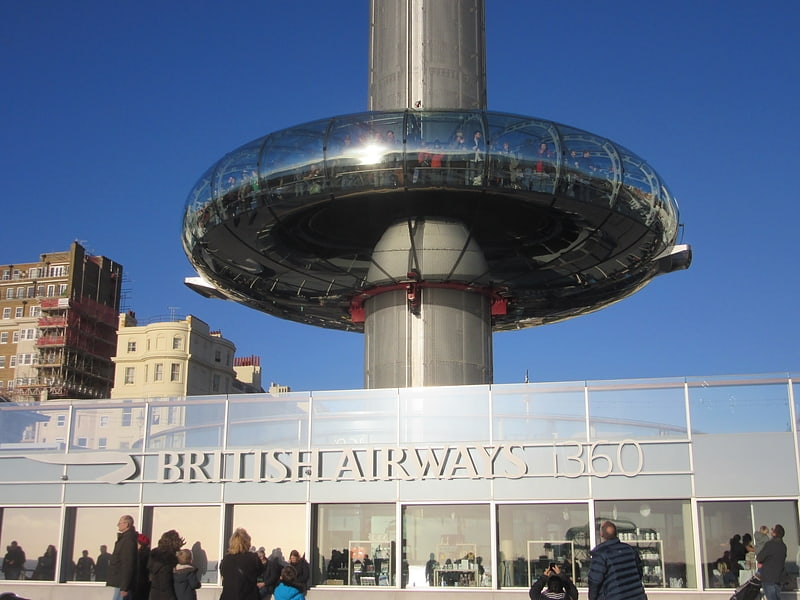
Tower in England. British Airways i360 is a 162 m observation tower on the seafront of Brighton, East Sussex, England at the landward end of the remains of the West Pier. The tower opened on 4 August 2016. From the fully enclosed viewing pod, visitors experience 360-degree views across Brighton, the South Downs and the English Channel.
British Airways i360 was designed, engineered, manufactured and promoted by the team responsible for the London Eye. The attraction cost £46 million, with £36 million being funded by a Public Works Loan Board (PWLB) loan through Brighton and Hove city council.
Formerly known as the "Brighton i360", the project aimed to attract 739,000 paying customers every year. The owner of the site, the West Pier Trust, hoped in 2014 that a successful i360 would lead to the rebuilding of the historic West Pier.[2]
Address: Lower Kings Road, BN1 2LN Brighton (Regency)
Brighton Museum & Art Gallery
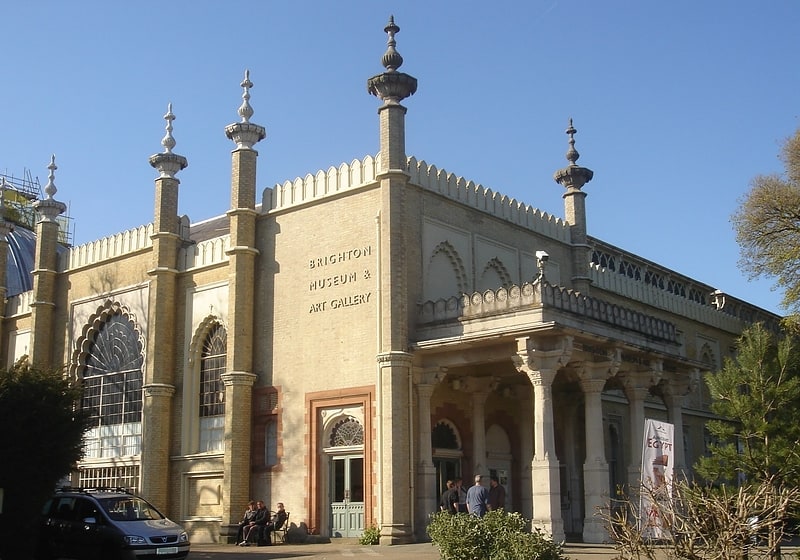
Brighton Museum & Art Gallery is a municipally-owned public museum and art gallery in the city of Brighton and Hove in the South East of England. It is part of the "Royal Pavilion & Museums, Brighton and Hove". It is free for local residents but charges £6.20 per non-resident.[3]
Address: 12A Pavilion Parade, BN1 1EE Brighton (Regency)
Brighton Toy and Model Museum

Museum in Brighton, England. Brighton Toy and Model Museum is an independent toy museum situated in Brighton, East Sussex. Its collection focuses on toys and models produced in the UK and Europe up until the mid-Twentieth Century, and occupies four thousand square feet of floor space within four of the early Victorian arches supporting the forecourt of Brighton railway station. Founded in 1991, the museum holds over ten thousand toys and models, including model train collections, puppets, Corgi, Dinky, Budgie Toys, construction toys and radio-controlled aircraft.
The display area includes large operational model railway layouts (in 0- and 00-gauge), and displays of period pieces from manufacturers and brands including Bing, Bassett-Lowke, Georges Carette, Dinky, Hornby Trains, Märklin, Meccano, Pelham Puppets and Steiff. It also includes individually engineered working models including a quarter-scale traction engine, steamroller and Spitfire fighter plane in the lobby.[4]
Address: 52-55 Trafalgar St, BN1 4EB Brighton (St. Peter's and North Laine)
Brighton Fishing Museum

Museum in England. The Brighton Fishing Museum is a registered independent museum established in co-operation with the local fishing community in 1994. This museum is dedicated to Brighton's fishing and seaside history. It is located a short distance to the west of Brighton Pier within an area known as the Fishing Quarter, occupying two of the arches on the Kings' Road, which runs along Brighton's beachfront. Admission is free and donations appreciated.
The history, traditions and practices of the fishing community are shared by a mix of images, artifacts and fishing boats. Archive and contemporary film, a slide show and a tape of fishing families talking and singing depict Brighton and the sea fishing industry from the 1800s to the 1990s.
Historical and technical research underpins the renovation of vernacular Sussex beach boats and marine engines. Works are carried out on the hard in front of the museum's workshop and the restored fishing and pleasure boats are drawn up on the hard and beach. Model boats are also displayed inside the museum.
Tradition and free public entertainments are combined in the Annual Brighton Mackerel Fair organised by the museum and the fishing community, every May.[5]
Address: 201 Kings Road Arches, BN1 1NB Brighton (Regency)
Clock Tower
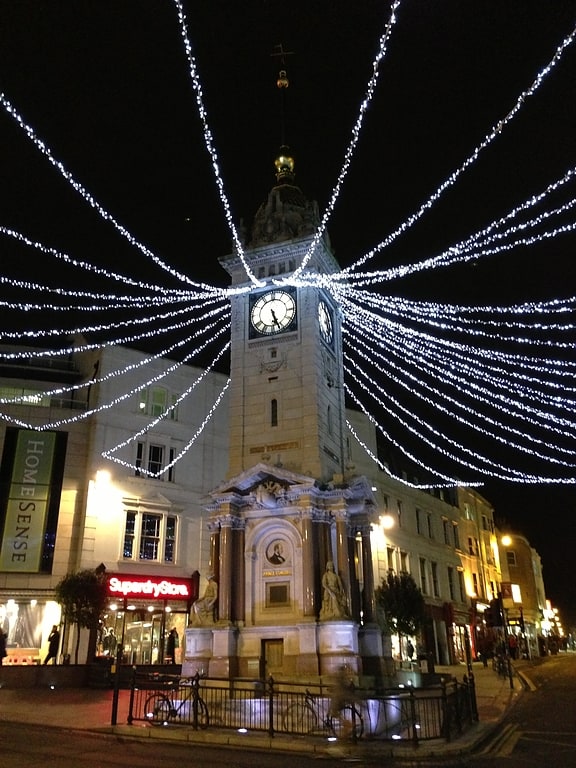
Tower in Brighton, England. The Clock Tower is a free-standing clock tower in the centre of Brighton, part of the English city of Brighton and Hove. Built in 1888 in commemoration of Queen Victoria's Golden Jubilee, the distinctive structure included innovative structural features and became a landmark in the popular and fashionable seaside resort. The city's residents "retain a nostalgic affection" for it, even though opinion is sharply divided as to the tower's architectural merit. English Heritage has listed the clock tower at Grade II for its architectural and historical importance.[6]
Address: West St, Brighton (Regency)
Marlborough Pub and Theatre
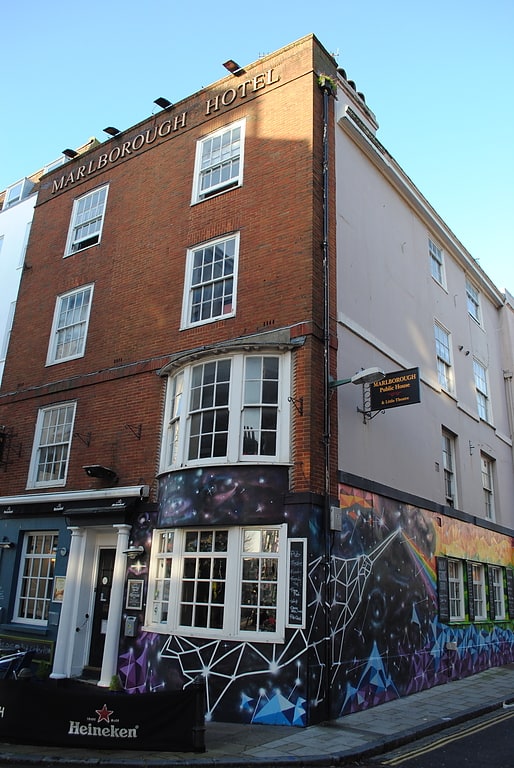
Theatre in Brighton, England. The Marlborough Pub and Theatre is a historic venue, situated at 4 Princes Street, Brighton. It has been associated, since the 1970s, with the LGBT community. Until 2020, the Marlborough's small theatre presented drama, cabaret and music throughout the year, including during the Brighton Fringe Festival, LGBT History Month and Brighton Pride Arts Festival. It is colloquially referred to as 'The Marlborough' or 'The Marly'.[7]
Address: 4 Prince's St, BN2 1RD Brighton (Queen's Park)
St Nicholas' Church

Anglican church in Brighton, England. The Church of Saint Nicholas of Myra, usually known as St. Nicholas Church, is an Anglican church in Brighton, England. It is both the original parish church of Brighton and, after St Helen's Church, Hangleton and St Peter's Church in Preston village, the third oldest surviving building in the city of Brighton and Hove. It is located on high ground at the junction of Church Street and Dyke Road in the city centre, very close to the main shopping areas. Due to its architectural significance the church is a Grade II* listed building.[8]
Address: Church St, BN1 3LJ Brighton (Regency)
Falmer Stadium
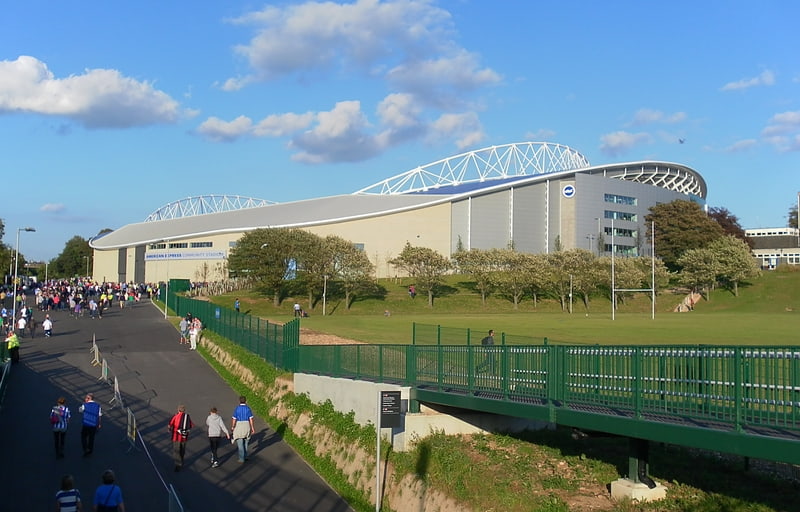
Stadium in Brighton, England. The Falmer Stadium, known for sponsorship purposes as the American Express Community Stadium and also referred to as the Amex, is a football stadium in the village of Falmer, in the City of Brighton and Hove, East Sussex, that serves as the home of Premier League club Brighton & Hove Albion. The stadium was handed over from the developers to the club on 31 May 2011. The first competitive game played at the stadium was the 2010–11 season final of the Sussex Senior Cup between Brighton and Eastbourne Borough on 16 July 2011. The first league game was against Doncaster Rovers, who were also the opponents in the last game played at Brighton's former stadium, the Goldstone Ground, 14 years earlier.
Falmer Stadium hosted Premier League football for the first time in August 2017, following Albion's promotion at the end of the 2016–17 season.
The stadium was designed to allow hosting for other sports and events. It hosted some matches from the 2015 Rugby World Cup.[9]
Address: Village Way, BN1 9BL Brighton (Moulsecoomb and Bevendean)
St Bartholomew's Church
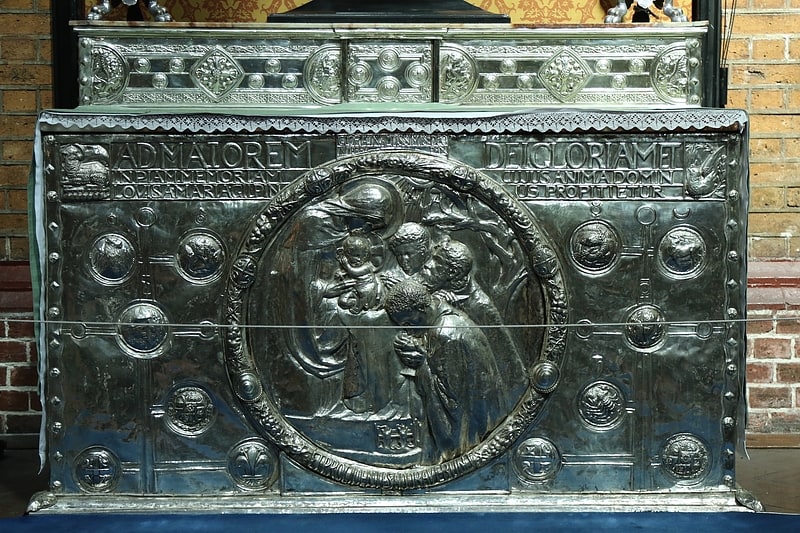
Church in Brighton, England. St Bartholomew's Church, dedicated to the apostle Bartholomew, is an Anglican church in Brighton, England. The neo-gothic building is located on Ann Street, on a sloping site between Brighton railway station and the A23 London Road, adjacent to the New England Quarter development. It is notable for its height – dominating the streets around it and being visible from many parts of the city – and its distinctive red-brick construction.[10]
Address: Ann St, BN1 4GP Brighton (St. Peter's and North Laine)
Old Steine Gardens
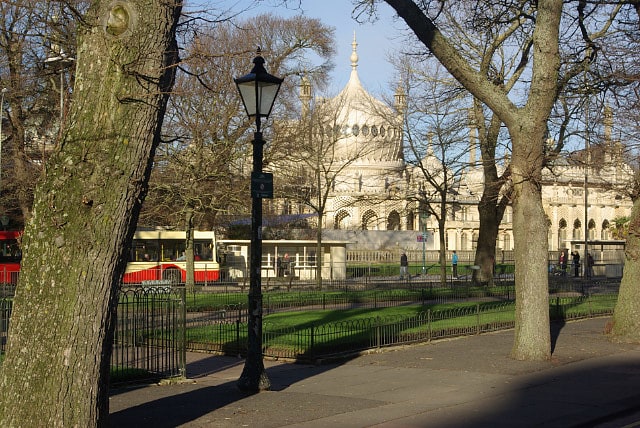
Park in Brighton, England. The Old Steine Gardens in Brighton, Brighton and Hove, East Sussex, England, adjacent to the Old Steine thoroughfare, are the site of several monuments of national historic significance.[11]
Address: Old Steine, BN1 1GY Brighton (Regency)
Preston Manor

Museum in Brighton, England. Preston Manor is the former manor house of the ancient Sussex village of Preston, now part of the coastal city of Brighton and Hove, England. The present building dates mostly from 1738, when Lord of the manor Thomas Western rebuilt the original 13th-century structure, and 1905 when Charles Stanley Peach's renovation and enlargement gave the house its current appearance. The manor house passed through several owners, including the Stanfords—reputedly the richest family in Sussex—after several centuries of ownership by the Diocese of Chichester and a period in which it was Crown property.
Since 1932, when the Stanford family bequeathed the building to Brighton Corporation, Preston Manor has been a museum and exhibition venue evoking upper-class life during the Edwardian era. A walled garden, designated as being of historic interest, has old flint walls, a ruined wellhouse and a pet graveyard, among other features. The manor house is reputed to be one of the most haunted buildings in Britain: it has been the subject of ghost tours and television programmes, and a wide range of ghostly sightings have been alleged over a long time period. English Heritage has listed the house at Grade II* for its architectural and historical importance; some other structures in the garden are listed at the lower Grade II.[12]
Address: Preston Road, BN1 6SD Brighton (Preston Park)
Duke of York's Picturehouse

Movie theater in Brighton, England. The Duke of York's Picture House is an art house cinema in Brighton, England, which lays claim to being the oldest cinema in continuous use in Britain. According to cinema historian Allen Eyles, the cinema "deserves to be named Britain's oldest cinema".
The cinema is a Grade II listed building.[13]
Address: Preston Circus, BN1 4NA Brighton (St. Peter's and North Laine)
British Engineerium
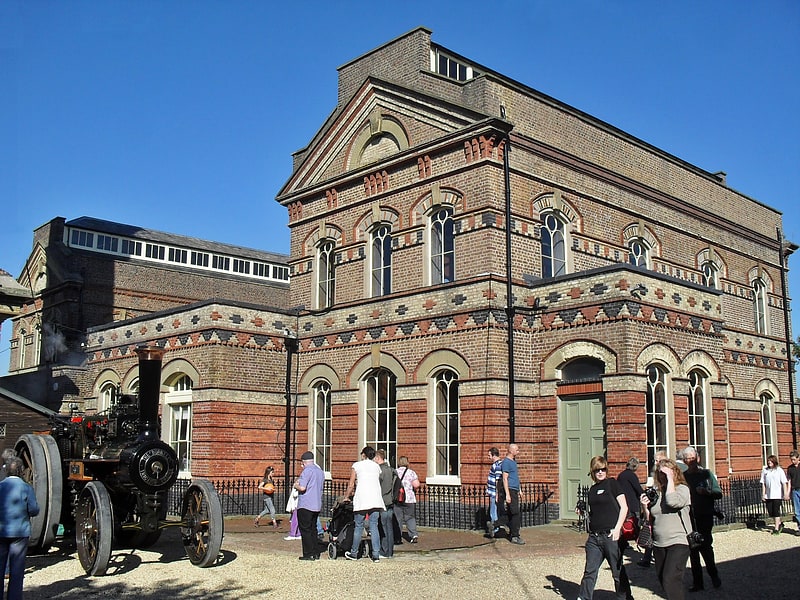
Museum in Hove, England. The British Engineerium is an engineering and steam power museum in Hove, East Sussex. It is housed in the Goldstone Pumping Station, a set of High Victorian Gothic buildings started in 1866. The Goldstone Pumping Station supplied water to the local area for more than a century before it was converted to its present use. The site has been closed to the public since 2006, and in March 2018, the entire complex was put up for sale.
At its greatest extent, between 1884 and 1952, the complex consisted of two boiler houses with condensing engines, a chimney, coal cellars, workshop, cooling pond, leat, and an underground reservoir. Situated on top of a naturally fissured chalk hollow, it provided vast quantities of water to the rapidly growing towns of Hove and its larger neighbour, the fashionable seaside resort of Brighton, for more than a century. As new sources of water were found elsewhere and more modern equipment installed to exploit them, the pumping station's importance declined, and by 1971 the Brighton Water Department had closed it and threatened the complex with demolition. An industrial archaeologist offered to restore the buildings and machinery in return for a lease from the Brighton Water Corporation, and a charitable trust was formed to enable this. Expertise developed by the Engineerium's employees and volunteers was exploited across the world: they founded museums, undertook restoration projects and trained young people in engineering heritage conservation. Another enthusiast subsequently bought the complex, and as of 2022 it is closed to the public while more restoration and extension work takes place.
The High Victorian Gothic buildings are a landmark in Hove, and are a good example of the 19th-century ethos that "utility definitely does not equal dullness" in industrial buildings. Polychrome brickwork, moulded dressings and facings, decorative gables and elaborate windows characterise all the structures – even the 95-foot (29 m) chimney, which stands apart from the main buildings like a campanile. English Heritage has listed the complex for its architectural and historical importance, giving its structures five separate listings: the former boiler house and the chimney are both listed at Grade II* – the second-highest designation – and the former coal shed, the cooling pond and leat and the tall flint and brick wall surrounding the site each have the lower Grade II status.
As well as the restored pumping station equipment, the complex has a wide range of exhibits: more than 1,500 were in place less than a year after it opened. These include a 19th-century horse-drawn fire engine, traction engines, veteran motorcycles, Victorian household equipment and old tools. A French-built horizontal steam engine dating from 1859 is the principal exhibit. The Engineerium has always used its exhibits to educate and promote the study of industrial history: it has been called "the world's only centre for the teaching of engineering conservation", and was central to the activities of the English Industrial Heritage Year in 1993. For many years, the larger and indigenous exhibits were fully operational and in steam at weekends.[14]
Address: The DroveWay, BN3 7QA Hove (Hove Park)
Brighton Dome
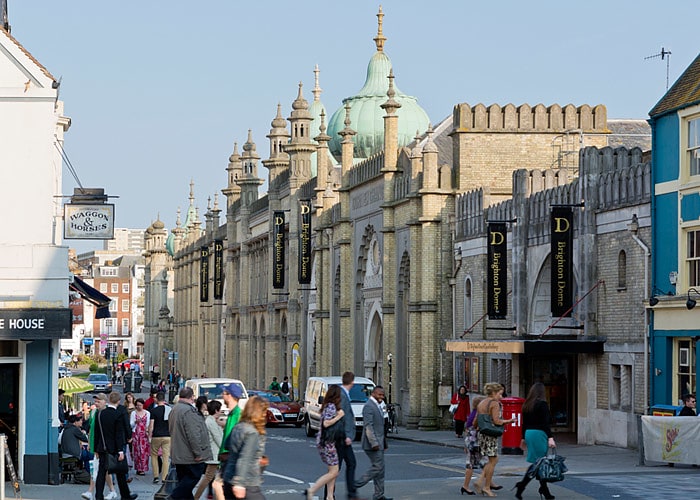
Theatre in Brighton, England. The Brighton Dome is an arts venue in Brighton, England, that contains the Concert Hall, the Corn Exchange and the Studio Theatre. All three venues are linked to the rest of the Royal Pavilion Estate by a tunnel to the Royal Pavilion in Pavilion Gardens and through shared corridors to Brighton Museum.[15]
Address: Pavilion Gardens Church Street, BN1 1UE Brighton (Regency)
Chapel Royal
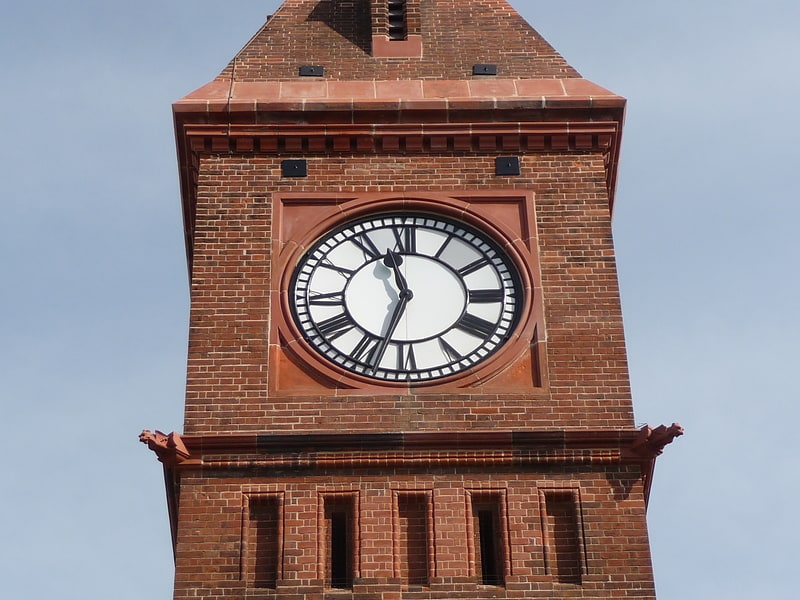
Church in Brighton, England. The Chapel Royal is an 18th-century place of worship in the centre of Brighton, part of the English city of Brighton and Hove. Built as a chapel of ease, it became one of Brighton's most important churches, gaining its own parish and becoming closely associated with the Prince Regent and fashionable Regency-era society. It remains an active church.[16]
Address: 164 North St, BN1 1EA Brighton (Regency)
Brighton Pier
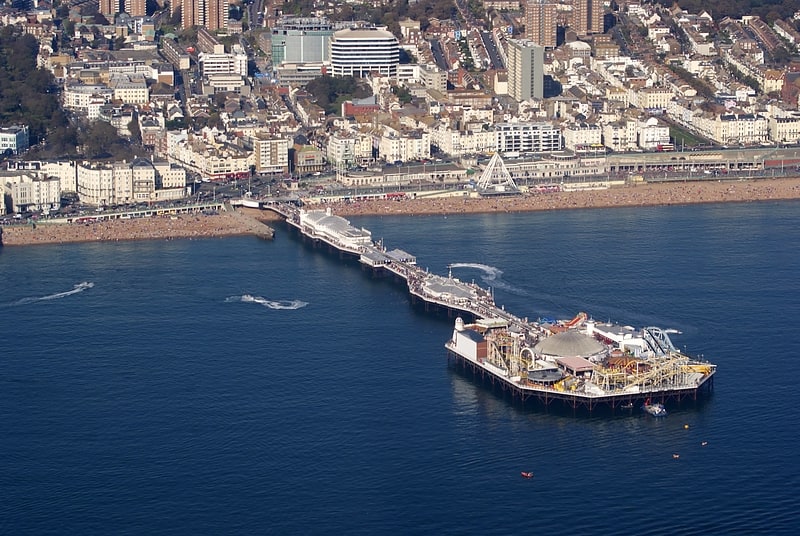
Iconic landmark and entertainment centre. The Brighton Palace Pier, commonly known as Brighton Pier or the Palace Pier, is a Grade II* listed pleasure pier in Brighton, England, located in the city centre opposite the Old Steine. Established in 1899, it was the third pier to be constructed in Brighton after the Royal Suspension Chain Pier and the West Pier, but is now the only one still in operation. It is managed and operated by the Eclectic Bar Group.
The Palace Pier was intended as a replacement for the Chain Pier, which collapsed in 1896 during construction of the new pier. It quickly became popular, and had become a frequently-visited theatre and entertainment venue by 1911. Aside from closures owing to war, it continued to hold regular entertainment up to the 1970s. The theatre was damaged in 1973 and following a buy-out was demolished in 1986, changing the pier's character from seaside entertainment to an amusement park, with various fairground rides and roller coasters.
The pier remains popular with the public, with over four million visitors in 2016, and has been featured in many works of British culture, including the gangster thriller Brighton Rock, the comedy Carry On at Your Convenience and the Who's concept album and film Quadrophenia.[17]
Address: Madeira Dr, BN2 1TW Brighton (Regency)
St Peter's Church

Commissioners' church in Brighton, England. St Peter's Church is a church in Brighton in the English city of Brighton and Hove. It is near the centre of the city, on an island between two major roads, the A23 London Road and A270 Lewes Road. Built from 1824–28 to a design by Sir Charles Barry, it is arguably the finest example of the pre-Victorian Gothic Revival style. It is a Grade II* listed building. It was the parish church of Brighton from 1873 to 2007 and is sometimes unofficially referred to as "Brighton's cathedral".[18]
Address: York Pl, BN1 4GU Brighton (St. Peter's and North Laine)
Adelaide Crescent

Building. Adelaide Crescent is a mid-19th-century residential development in Hove, part of the English city and seaside resort of Brighton and Hove. Conceived as an ambitious attempt to rival the large, high-class Kemp Town estate east of Brighton, the crescent was not built to its original plan because time and money were insufficient. Nevertheless, together with its northerly neighbour Palmeira Square, it forms one of Hove's most important architectural set-pieces. Building work started in 1830 to the design of Decimus Burton. The adjacent land was originally occupied by "the world's largest conservatory", the Anthaeum; its collapse stopped construction of the crescent, which did not resume until the 1850s. The original design was modified and the crescent was eventually finished in the mid-1860s. Together with the Kemp Town and Brunswick Town estates, the crescent is one of the foremost pre-Victorian residential developments in the Brighton area: it has been claimed that "outside Bath, have no superior in England". The buildings in the main part of Adelaide Crescent are Grade II* listed. Some of the associated buildings at the sea-facing south end are listed at the lower Grade II.[19]
The Level
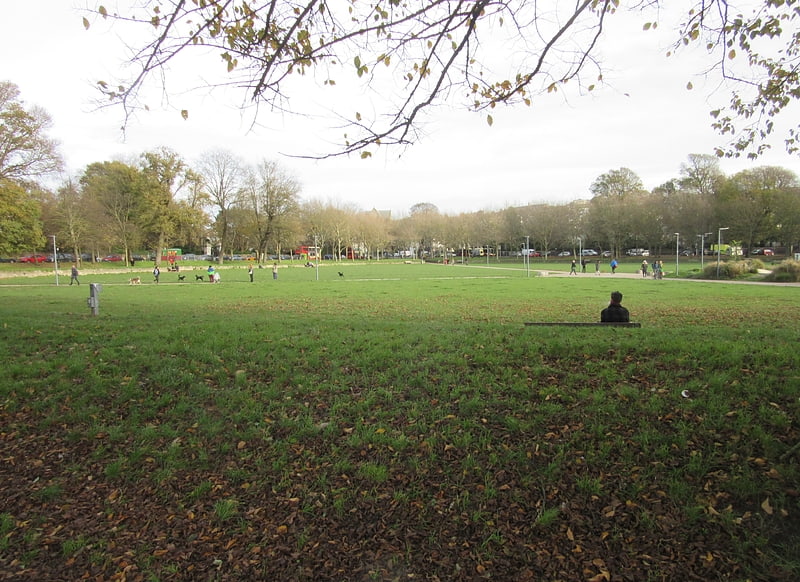
The Level is an urban park in central Brighton, on the south coast of England. The park is a triangle of 8.05 acres bounded by Union Road to the north, Richmond Terrace to the east, and Ditchling Road to the west. In the past, the land has been used as a cricket ground for the Prince of Wales and as a setting for large-scale dinner parties to commemorate events such as the defeat of Napoleon Bonaparte and the coronation of Queen Victoria.
The Level is often used for public meetings and gatherings. These have included May Day events, a 1983 peace camp and the Brighton Urban Free Festival. Present day features of the park include a grassed area with elm trees and outdoor seating, a skatepark, public toilets, a rose garden, a children's playground and a water feature. The park was substantially redeveloped from 2009 onwards.[20]
Address: Lewes Rd., BN2 9SY Brighton (St. Peter's and North Laine)
Galeed Strict Baptist Chapel
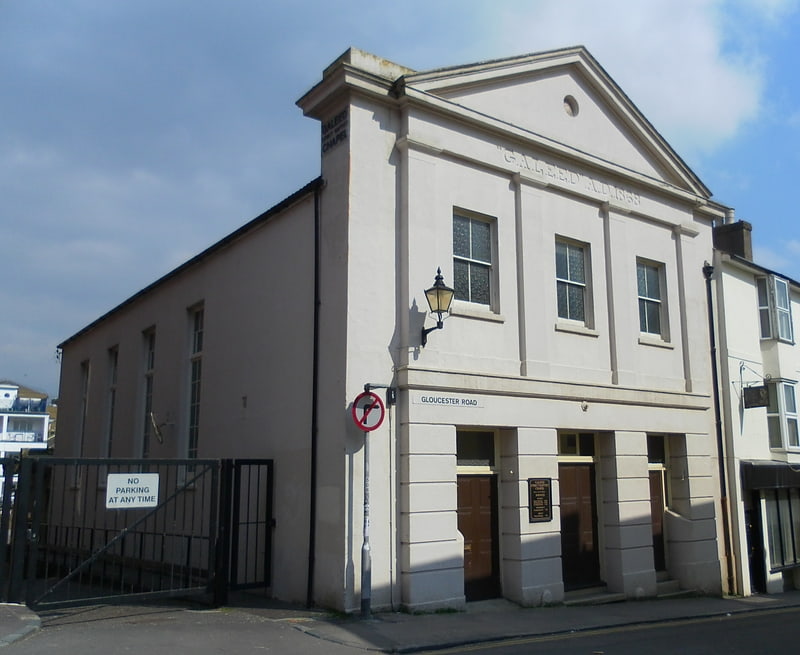
Galeed Strict Baptist Chapel is a Strict Baptist place of worship in the North Laine area of Brighton, part of the English seaside city of Brighton and Hove. It was built in 1868 in an "austere Neoclassical" style for members of a newly formed church who had been worshipping in a hired building nearby since seceding from another chapel elsewhere in Brighton in 1867 as a result of doctrinal differences. The chapel, which has changed little since it opened, remains in use by Gospel Standard Strict Baptists and is the only such place of worship remaining in the city. It is situated in a conservation area and is a locally listed building. People associated with Galeed Chapel include the founders of the Evangelical Library and the Gospel Standard Baptist Library, several editors of the Gospel Standard magazine, and the author of a definitive history of the Strict Baptist movement. Regular services are held on Sundays, Wednesdays and Fridays.[21]
Address: 80 Gloucester Road, Brighton (St. Peter's and North Laine)
11 Dyke Road
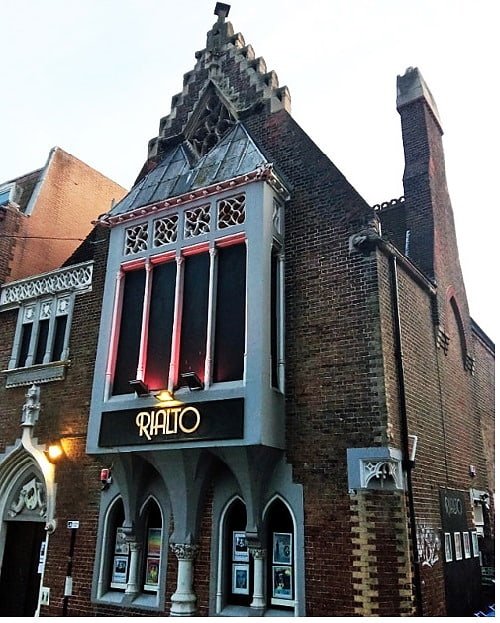
Theatre. The building at 11 Dyke Road in Brighton, part of the English city of Brighton and Hove, is now the Rialto Theatre, but it originally housed the Swan Downer School for poor girls, for whom it was designed and built in 1867 by prolific architect George Somers Leigh Clarke. The highly ornate brick structure, in a "freely inventive" European Gothic style, has also served as a chapel and an office since it was vacated by the school, whose pupils were recognisable around Brighton in their blue and white uniform. English Heritage has listed the building at Grade II for its architectural and historical importance.[22]
Address: 11 Dyke Road, Brighton (Regency)
Theatre Royal
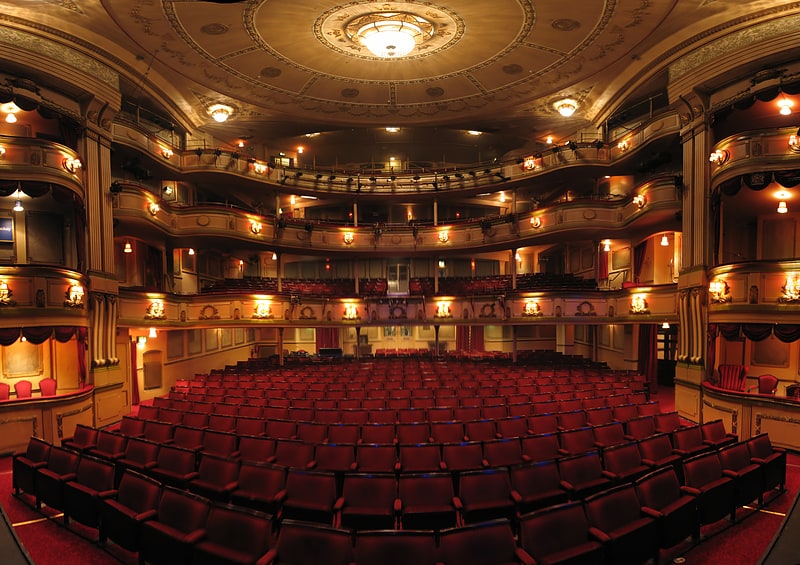
Theatre in Brighton, England. The Theatre Royal, Brighton is a theatre in Brighton, England presenting a range of West End and touring musicals and plays, along with performances of opera and ballet.[23]
Address: Brighton, New Road
Brighton Friends Meeting House
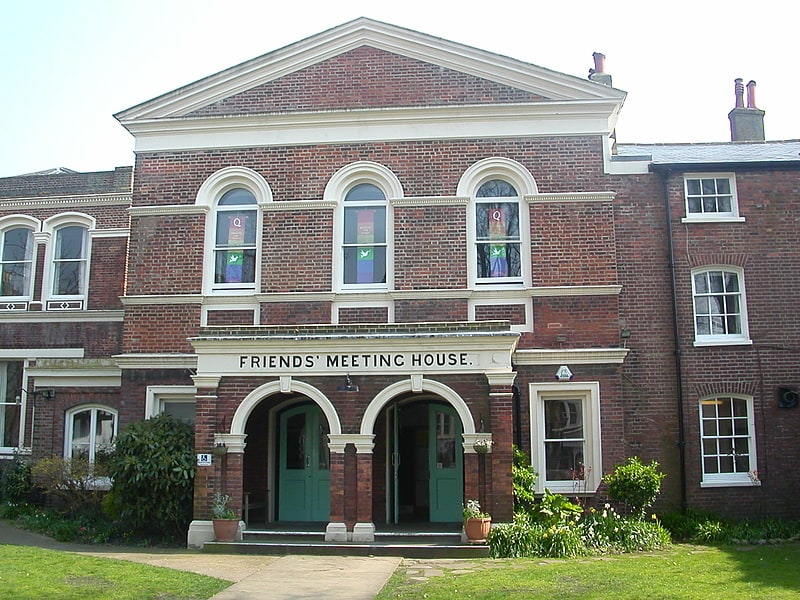
Friends meeting house in Brighton, England. The Brighton Friends Meeting House is a Friends meeting house in the centre of Brighton, part of the city of Brighton and Hove in East Sussex, England. The building, which dates from 1805, replaced an earlier meeting house of 1690 what was then a small fishing village on the Sussex coast. Located at the junction of Ship Street and Prince Albert Street in The Lanes, the heart of Brighton's "old town" area, its architectural and historic importance has been recognised by English Heritage's granting of Grade II listed status.[24]
Address: 17-18 Prince Albert St, BN1 1HF Brighton (Regency)
St Paul's Church
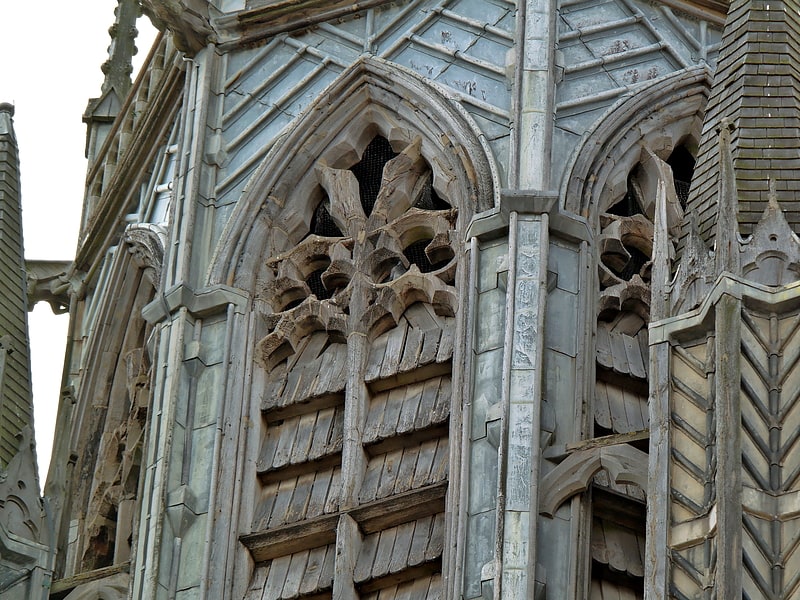
Church in Brighton, England. St Paul's Church, dedicated to the missionary and Apostle to the Gentiles Paul of Tarsus, is a Church of England parish church in Brighton in the English county of Sussex. It is located on West Street in the city centre, close to the seafront and the main shopping areas.[25]
Address: West St, BN1 2RQ Brighton (Regency)
Brighton and Hove National Spiritualist Church
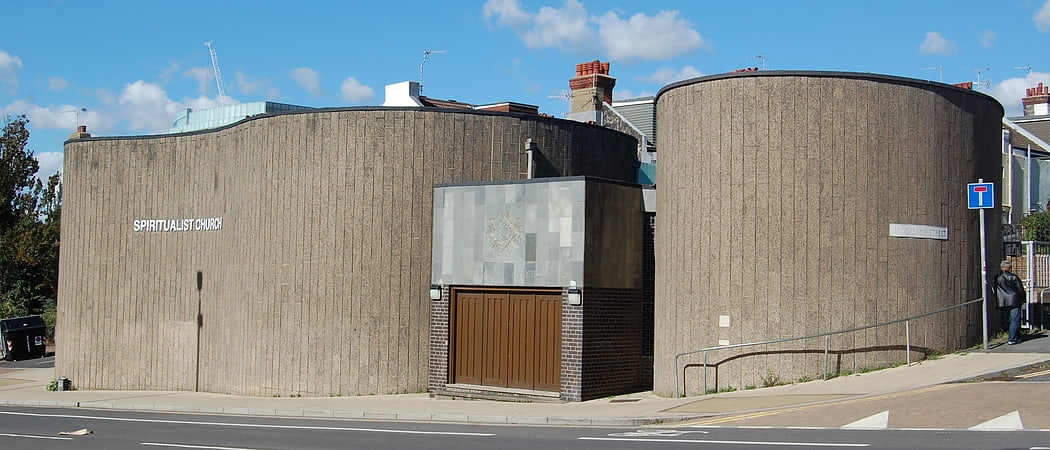
Brighton and Hove National Spiritualist Church, known until 2019 as Brighton National Spiritualist Church, is a Spiritualist place of worship in the Carlton Hill area of Brighton, part of the English seaside city of Brighton and Hove. Since its amalgamation with another church in the city in November 2019, it has been one of England's largest Spiritualist churches.
The church was formed in 1902 and has occupied various premises since then. The present building, which has been registered as a place of worship since 1965, is architecturally significant for its curved, windowless Brutalist form. It has been recognised as a locally listed heritage asset by Brighton and Hove City Council.[26]
Address: 62 Edward Street, Brighton (Queen's Park)
St Mary's Church
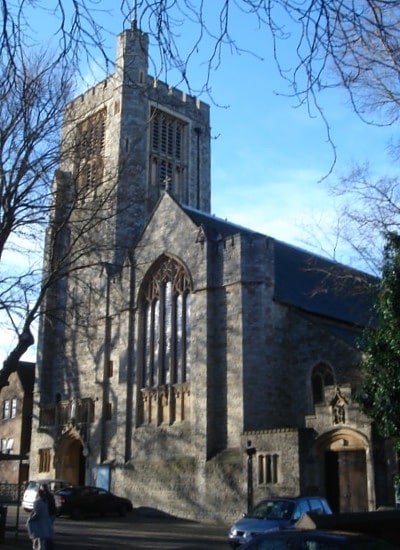
Parish church. St Mary's Church is a Roman Catholic Parish church in the Preston Village area of Brighton and Hove, East Sussex, England. It was built from 1910 to 1912 in the Arts and Crafts style of Gothic Revival architecture. It is situated on the Surrenden Road on the corner with Preston Drove opposite Preston Park. It was designed by Percy Aiden Lamb, a student of Edward Goldie, and is a Grade II listed building.[27]
Address: 5 Surrenden Rd, BN1 6PA Brighton (Withdean)
Brighton Unitarian Church
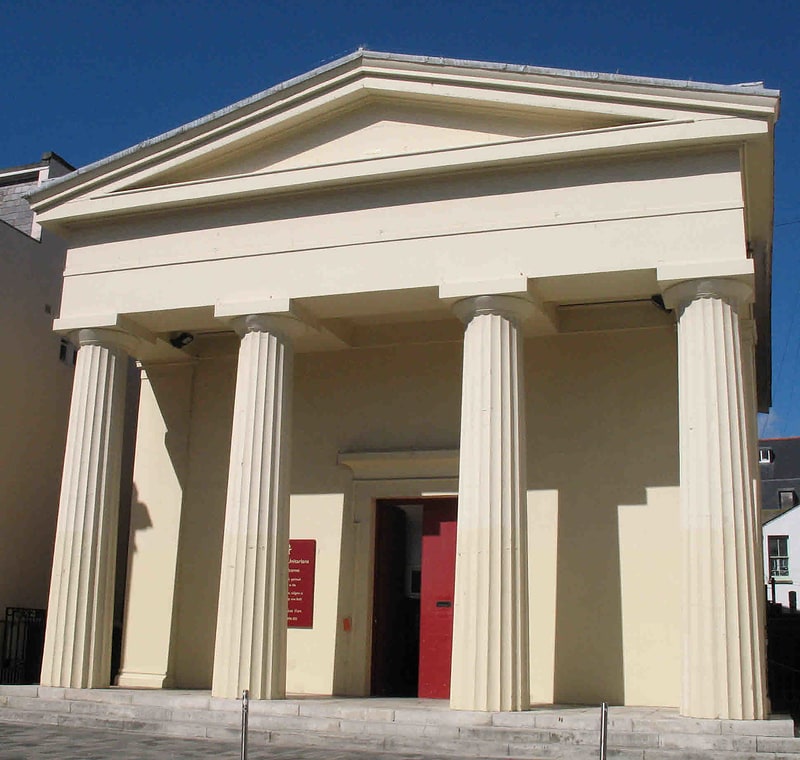
Church in Brighton, England. The Brighton Unitarian Church, previously known as Christ Church, is a Unitarian chapel in Brighton, England. Built in 1820 by prolific local architect Amon Henry Wilds on land sold to the fledgling Unitarian community by the Prince Regent, the stuccoed Greek Revival building occupies a prominent position near the corner of Church Road and New Road in the centre of Brighton, near the Royal Pavilion and the city's main theatres. It has had Grade II listed status since 1952. It is a member of the General Assembly of Unitarian and Free Christian Churches, the umbrella organisation for British Unitarians.[28]
Address: New Rd, BN1 1UF Brighton (St. Peter's and North Laine)
St Peter's Church
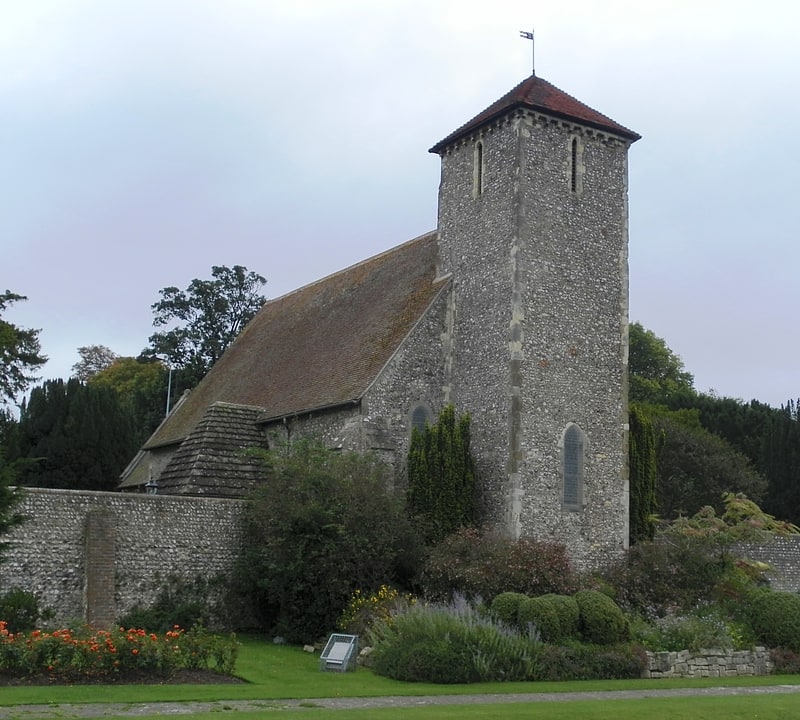
Church in Brighton, England. St Peter's Church is a former Anglican church in the Preston Village area of Brighton, in the English city of Brighton and Hove. The 13th-century building, standing on the site of two older churches, was restored in the late 19th century and again after a serious fire in 1906. It was the parish church of Preston until 1908, when the newly built St John the Evangelist's Church gained this status. The Diocese of Chichester declared St Peter's redundant in 1990, and it is now owned by the Churches Conservation Trust. It has Grade II* listed status, reflecting its architectural and historical importance.[29]
All Saints Church
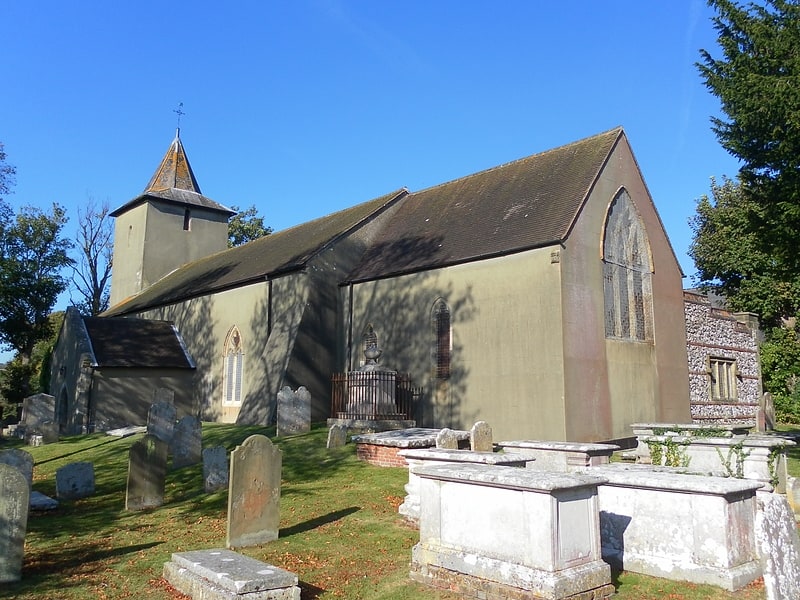
Church in Brighton, England. All Saints Church is the Anglican parish church of Patcham, an ancient Sussex village which is now part of the English city of Brighton and Hove. A place of worship has existed on the hilltop site for about 1,000 years, but the present building has Norman internal features and a 13th-century exterior. Several rounds of restoration in the Victorian era included some structural additions. A wide range of monuments and wall paintings survive inside, including one commemorating Richard Shelley—owner of nearby Patcham Place and one of the most important noblemen in the early history of Brighton. The church, which is Grade II* listed, continues to serve as the Anglican place of worship for residents of Patcham, which 20th-century residential development has transformed from a vast rural parish into a large outer suburb of Brighton.
Patcham's first church served a large rural area north of the fishing village of Brighthelmston—the ancient predecessor of Brighton. A nucleated settlement developed around this building, which was reconstructed during the Norman era. A wide-ranging series of alterations were carried out by Victorian church restorers to improve the building's structural condition and provide more space to cater for the growing population. As Patcham developed into a suburb in the 20th century, more churches opened in the area and were administered from All Saints Church. The building's plain exterior contrasts with its well-preserved and, in parts, ancient interior whose features include wall paintings and stone memorials. The churchyard has a set of Grade II-listed tombs.[30]
Brighton Town Hall
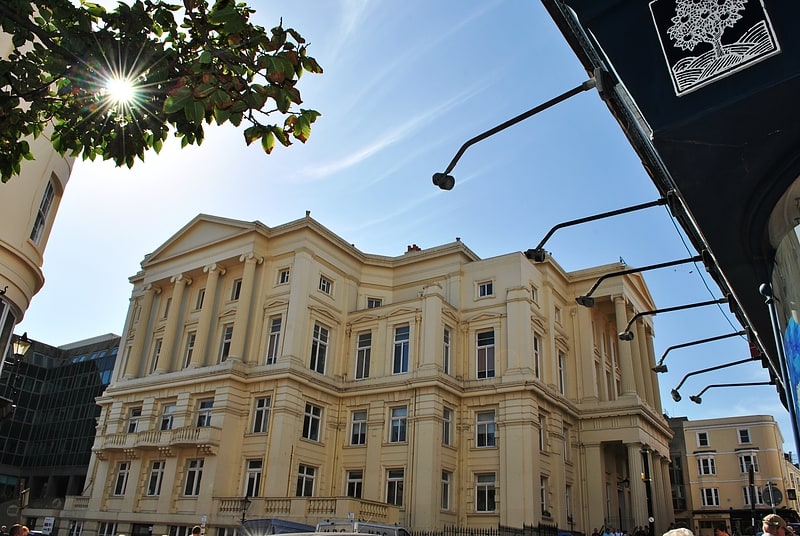
Civic center in Brighton, England. Brighton Town Hall stands on Bartholomew Square in Brighton, East Sussex, England. The town hall contains a number of police cells which were in use until the 1960s, and which now form the Old Police Cells Museum. The town hall is a Grade II listed building.[31]
Palmeira Square
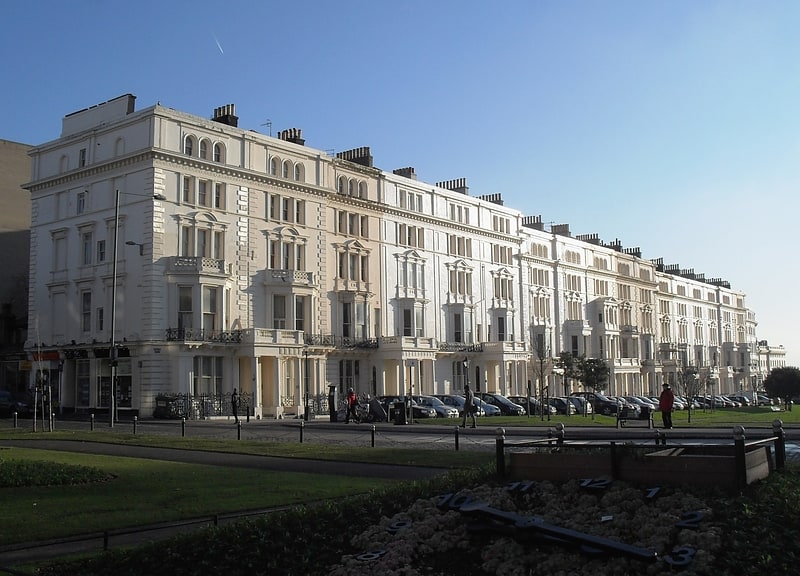
Palmeira Square is a mid-19th-century residential development in Hove, part of the English city and seaside resort of Brighton and Hove. At the southern end it adjoins Adelaide Crescent, another architectural set-piece which leads down to the seafront; large terraced houses occupy its west and east sides, separated by a public garden; and at the north end is one of Hove's main road junctions. This is also called Palmeira Square, and its north side is lined with late 19th-century terraced mansions. Commercial buildings and a church also stand on the main road, which is served by many buses.
The land was originally occupied by "the world's largest conservatory", the Anthaeum—a visitor attraction planned by botanist, author and building promoter Henry Phillips. The giant dome's collapse and total destruction on the day it was due to open in 1833 made Phillips go blind from shock, and the debris occupied the site for many years. Work began in the early 1850s and was largely complete in the mid-1860s, although commercial and residential buildings such as Palmeira House and Gwydyr Mansions continued to be added at the northern end throughout the late 19th century. English Heritage has listed the residential buildings on the western, eastern and northern sides of the square at Grade II for their architectural and historical importance, although one building has the higher Grade II* status because of its opulent custom-designed interior.[32]
Address: 33 Palmeira Mansions Church Road, BN3 2GB Hove
Whitehawk Camp
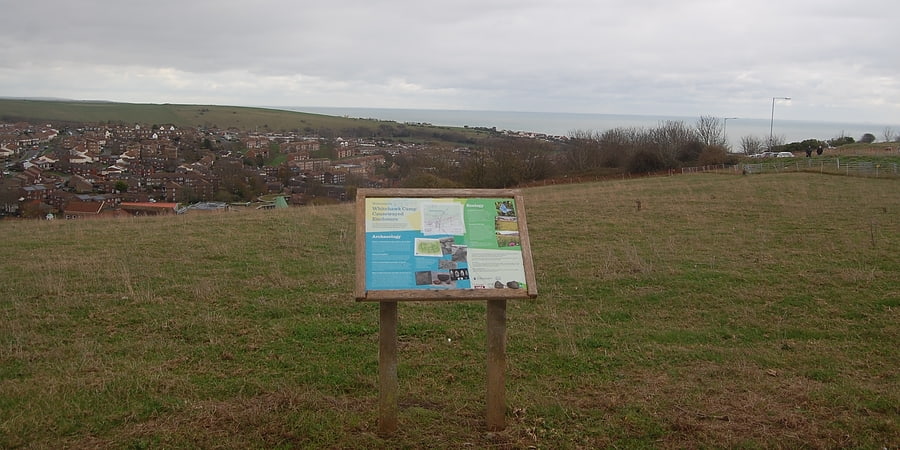
Whitehawk Camp is the remains of a causewayed enclosure on Whitehawk Hill near Brighton, East Sussex, England. Causewayed enclosures are a form of early Neolithic earthwork that were built in England from shortly before 3700 BC until about 3300 BC, characterized by the full or partial enclosure of an area with ditches that are interrupted by gaps, or causeways. Their purpose is not known; they may have been settlements, or meeting places, or ritual sites. The Whitehawk site consists of four roughly concentric circular ditches, with banks of earth along the interior of the ditches evident in some places. There may have been a timber palisade on top of the banks. Outside the outermost circuit there are at least two more ditches, one of which is thought from radiocarbon evidence to date to the Bronze Age, about two thousand years after the earliest dated activity at the site.
Whitehawk was first excavated by R. P. Ross Williamson and E. Cecil Curwen in 1929 in response to a plan to lay out football pitches on the site. Brighton Racecourse overlaps Whitehawk Camp, and when an expansion of the course's pulling-up ground affected part of the site, Curwen led another rescue dig in the winter of 1932–1933; similarly in 1935 the area to be crossed by a new road was excavated, again by Curwen. In 1991, during the construction of a housing development near the site, one of the ditches outside the outermost circuit was uncovered, and the construction was paused to allow an excavation, run by Miles Russell. In 2011, the Gathering Time project published an analysis of radiocarbon dates from almost forty British causewayed enclosures, including several from Whitehawk Camp. The conclusion was that the Neolithic part of the site was probably constructed between 3650 and 3500 BC, and probably went out of use some time between 3500 and 3400 BC. The site was designated as a scheduled monument in 1923.[33]
Montpelier Place Baptist Church
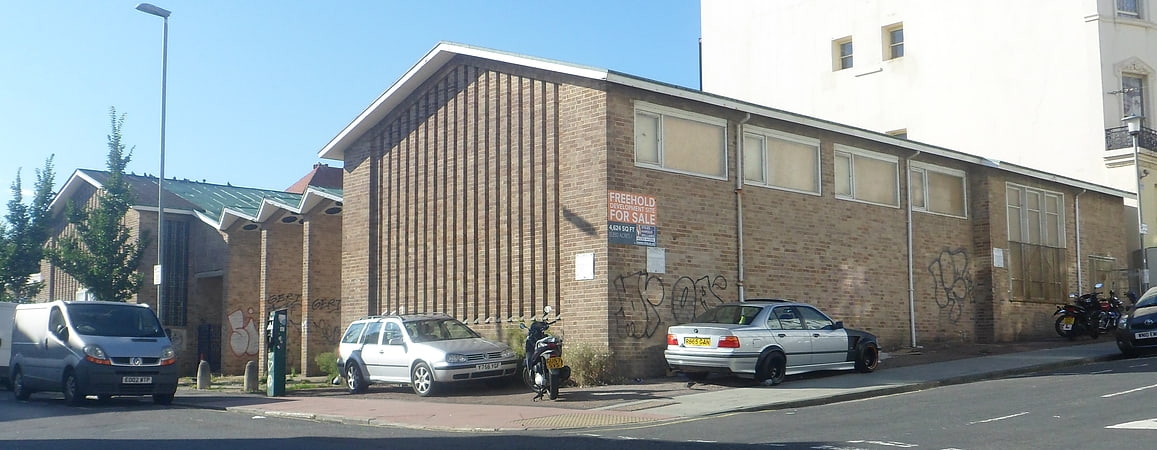
Montpelier Place Baptist Church, originally known as the Baptist Tabernacle, is a former Baptist church in the Montpelier area of Brighton, part of the English seaside city of Brighton and Hove. It opened in 1967 to replace a 140-year predecessor on West Street in central Brighton, but was closed in 2012 and demolished over the 2017–2018 Christmas and New Year period. Houses and flats now occupy the site; the development was completed in December 2019.
The Tabernacle in West Street served Independent Calvinistic worshippers at first, but its doctrines later changed to Strict Baptist. Its successor maintained this character, and in its later years—along with another church in Brighton—was a member of an organisation for Reformed Evangelical Christian churches. Decline in the 21st century led to its closure and a period of dereliction during which it was squatted. The building was starkly Modernist in style, with echoes of Basil Spence's Coventry Cathedral—a contrast to the Classical appearance of the West Street Tabernacle.[34]
Volk's Electric Railway

Railway. Volk's Electric Railway is a narrow gauge heritage railway that runs along a length of the seafront of the English seaside resort of Brighton. It was built by Magnus Volk, the first section being completed in August 1883, and is the oldest operational electric railway in the world, though it was not the first electric railway to be built. It was preceded by electrification of Miller's line in 1875, Werner von Siemens' 1879 demonstration line in Berlin and by the Gross-Lichterfelde Tramway of 1881, although none of these now remains in operation.
Operated as an historical seafront tourist attraction, the railway does not usually run during the winter months, and its service is also liable to occasional suspension due to severe weather or maintenance issues.[35]